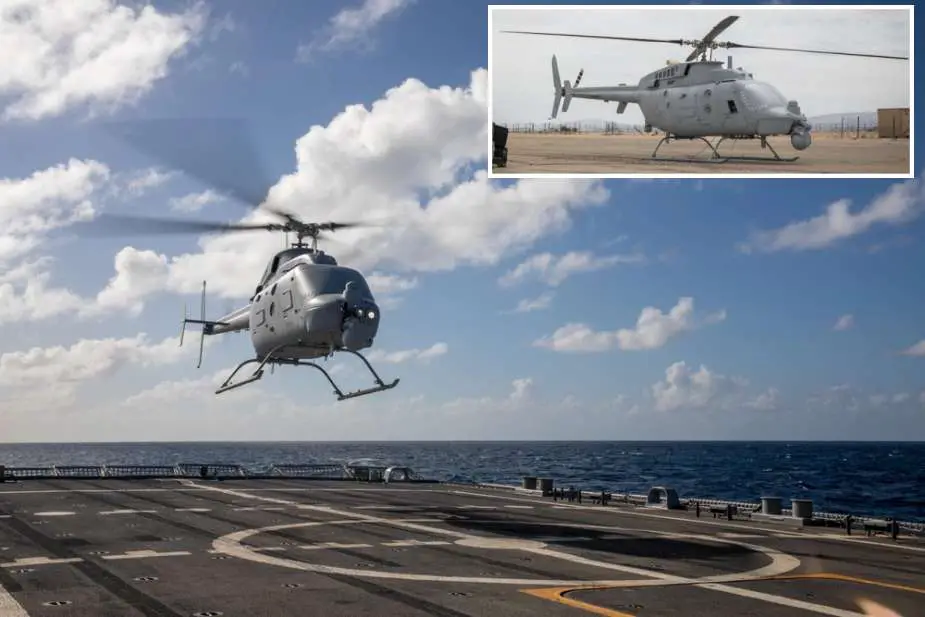Breaking news
US Marine Corps successfully refuels unmanned MQ-8C helicopter in mid-flight.
According to Defense Advancement on August 25, 2023, the U.S. Marine Corps successfully conducted a mid-flight aerial delivered ground refueling (ADGR) trial of an autonomous MQ-8C Fire Scout helicopter using a Marine Corps CH-53E Super Stallion heavy helicopter.
Follow Air Recognition on Google News at this link
 The US Marine Corps successfully refueled in mid-flight an unmanned MQ-8C helicopter drone (Picture source: US DoD)
The US Marine Corps successfully refueled in mid-flight an unmanned MQ-8C helicopter drone (Picture source: US DoD)
The ADGR trial was conducted as a part of the Service Level Training Exercise (SLTE) 5-23, with collaboration between Marine Heavy Helicopter Squadron (HMH) 361 and Helicopter Sea Combat Squadron (HSC) 21. The trial enabled the transfer of fuel from the CH-53E helicopter to the MQ-8C Fire Scout, an unmanned sea-based helicopter.
The success of the trial was facilitated by the CH-53E's dual capability to refuel both air and ground vehicles, allowing for the transfer of approximately 700 pounds of fuel to the MQ-8C. The trial utilized the MQ-8C's operational range of 150 nautical miles and drew upon the CH-53E's maximum fuel payload of 23,450 pounds, resulting in an estimated range of 540 nautical miles.
The operational significance of this achievement lies in its demonstration of compatibility between conventional manned aircraft and advanced unmanned systems. The trial also showcased the MQ-8C's extended operational endurance through multiple refueling cycles, enhancing its effectiveness in combat scenarios.
Lt. Cmdr. Brian “Freq” Paskey, the training officer of HSC-21, discussed the broader implications of the achievement, noting the potential applicability of the MQ-8C in supporting Marine Air-Ground Task Force operations in various environments. Lt. Col. Nathaniel Griggs, the Director of Aviation Combat and Integration (AC&I) at Marine Air-Ground Task Force Training Command, emphasized the broader relevance of the achievement, stating that the lessons learned from the trial could be applicable in diverse situations.
The MQ-8C Fire Scout, developed for the United States Navy by Northrop Grumman, is an unmanned helicopter that demonstrates advancements in modern aerial systems. Its technical specifications underscore its potential utility in naval operations, without introducing bias.
Debuting in October 2013 after its developmental phase under the designation Fire-X, the MQ-8C showcased its autonomous take-off and landing capabilities, setting the stage for versatile naval applications. By utilizing the Bell 407 airframe and incorporating avionics and systems from the MQ-8B Fire Scout, the MQ-8C aims for efficient operational performance.
The helicopter's dimensions include a length of 34 feet 8 inches (10.6 meters) and a height of 10 feet 11 inches (3.3 meters). Its maximum takeoff weight reaches 6,000 pounds (2,721 kilograms), and it is powered by a Rolls-Royce 250-C47B engine producing 813 shp (606 kW). With a main rotor diameter of 36 feet 7 inches (11.2 meters), it offers agility for various tasks.
Operating at a maximum speed of 140 knots (160 mph, 260 km/h), the MQ-8C Fire Scout is suitable for reconnaissance and data collection missions. Its endurance of up to 15 hours and a range of 150 nautical miles considerably extend its operational capabilities. With a payload capacity of around 701 pounds (318 kg), it can accommodate diverse mission equipment, such as sensors, cameras, and guided rocket pods.
The MQ-8C Fire Scout's operational integration with Littoral Combat Ships (LCS) and autonomous capabilities are noteworthy. Its mission focus shifted in 2019 from primarily serving as a weapons platform to concentrating on offering targeting and surveillance data. This strategic repositioning aligns with the Navy's objective to optimize the helicopter's endurance and advanced radar system for effective over-the-horizon targeting capabilities.
By January 2023, the U.S. Navy had obtained 38 MQ-8Cs, out of which 10 were actively engaged in operational tasks, while the remaining units were held in storage. This acquisition reflects the Navy's dedication to incorporating unmanned technology as part of its operational structure.



















